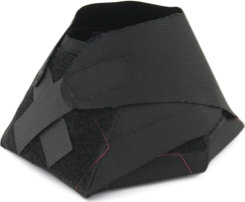Jason wrote a comment on a previous article "Functional Horseman's Saddle Guns" where he recommended "a handgun in 44 caliber or 10mm if a semi automatic". Ralph P. sent an e-mail "cautioning me that revolvers were hard to shoot and therefore semi-automatic handguns were best suited." Okay, lets talk about semi-automatics as a horseback gun.
When a cartridge is fired in a semi-automatic handgun the gun powder in the case is turned to gas which propels the bullet from 0 fps to 800 up to 1400 fps, depending upon what caliber and cartridge you are firing. This is a controlled explosion which not only propels the bullet downrange but actuates the slide of the semi-automatic pushing it rearwards so the extractor can grab the empty case and as the slide reaches it's final rearward position, an ejector hits the empty cases knocking it away from the gun. The slide under spring tension then moves forward stripping a new cartridge from the top of the magazine and chambering that cartridge (aka round) into the chamber of the barrel and the gun is ready to fire again,...and repeat that cycle.
When semi-automatic handguns are designed, they are made to function (operate reliably) when the frame of the handgun is held in a relatively tight grip. A loose grip on the handgun, especially so when shooting one handed (often called "limp wristed shooting') can often not provide a tight enough grip for the slide to actuate fully against and often results in a malfunction.
The issue for shooting on horseback with a semi-automatic is that it most often has to be done one handed and bad habits are magnified when you are shooting from a moving platform - a horse.
The picture and sub-set above right show bad habits that retard the movement of the slide of the semi automatic handgun and can therefore more likely create a malfunction. These bad habits include shooting with a less than firm grip on the gun and with a bent elbow. Shooters will often bend their elbows and bring the gun's sights closer to them thinking that it will help them get a better sight picture, when the opposite is the case. With a bent elbow you also reduce your ability to control recoil and muzzle rise. The picture in the sub-set also shows the shooter leaning off his horse's centerline. I can shoot off this horse, but if surprised by the gun shot he may move his feet alittle and if I am leaning as he moves, it will be harder to get a accurate second or third shot off.
The picture above, shooting with an extended arm (elbow locked) and shoulder raised (like hunching your shoulders) provide a firm platform for the handgun to recoil against and operate as designed, and allows the shooter to control the recoil and muzzle more effectively.
Semi-automatics will have a much less trigger weight - the amount of pressure it takes to pull the trigger - than a double action revolver. Another bad habit is to keep your finger on the trigger while trying to control your horse using the reins in the other hand. There is a condition call "para-sympathetic reflex" where under stress if you pull or grab with the off hand, the gun hand may also contract and can pull the trigger causing a unintended and negligent discharge of a round.
When I worked as a Conservation Law Enforcement Officer I carried whatever handgun I wanted as long as I could qualify with it. I chose a Double Action Smith and Wesson Model 686 revolver in a 4 inch barrel in .357 Magnum caliber. When our agency later mandated we carry Beretta Model 92SF semi-automatics in 9mm, I spent some time educating our agency management about the pros and cons of semi-auto versus revolver. I lost the case and to further handicap us, management also mandated we use lanyards connecting the gun to our belts via a elastic telephone cord type of get up. While it may make sense for some people on horseback to have a lanyard for their handgun, the last thing I or my fellow Range Riders wanted was another rope like doodad to get hung up on when mounting or dismounting to riding through heavy brush. Gun retention can be solved by a quality holster and training.
I have worked with other Law Enforcement Officers helping them get their horses sacked out to shoot from and virtually all of them were required to use an agency specified semi-automatic handgun. Eliminating bad shooting habits became important, especially for Border Patrol agents along the Mexico-U.S. border who potentially face heavily armed drug smugglers or bandits each shift.
I'm sure we can agree that not only does a handgun have to be able to be used effectively by a rider - and this is a training issue - the gun needs to be reliable and the cartridge sufficient to do the intended job. The needs of a horseback law enforcement officer, who works mainly in a people populated area are likely different versus a back country guide exposed to dangerous game like mountain lions or grizzly bears. And both maybe be somewhat different from a recreational rider carrying a handgun for personal protection or for snakes.



















No comments:
Post a Comment